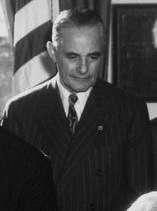Richardson Dilworth
Richardson K. Dilworth (August 29, 1898 – January 23, 1974)[1] was an American Democratic Party politician who served as the 117th mayor of Philadelphia from 1956 to 1962. He twice ran as the Democratic nominee for governor of Pennsylvania, in 1950 and in 1962.
Richardson Dilworth | |
|---|---|
 Dilworth in 1961 | |
| 91st Mayor of Philadelphia | |
| In office January 2, 1956 – February 12, 1962 | |
| Preceded by | Joe Clark |
| Succeeded by | James Tate |
| 16th District Attorney of Philadelphia | |
| In office January 7, 1952 – January 2, 1956 | |
| Preceded by | John Maurer |
| Succeeded by | Victor Blanc |
| Personal details | |
| Born | August 29, 1898 Pittsburgh, Pennsylvania, U.S. |
| Died | January 23, 1974 (aged 75) |
| Nationality | American |
| Political party | Democratic |
| Spouse(s) | Ann Elizabeth Kaufman |
| Children | 2 |
| Alma mater | Yale University |
| Military service | |
| Allegiance | |
| Branch/service | |
| Rank | Major |
| Battles/wars | World War I World War II |
Education and early career
He was born in Pittsburgh to Joseph Richardson Dilworth and Annie Hunter (Wood) Dilworth. He enlisted in the Marine Corps in World War I and was commissioned as an officer in World War II. In 1938, he joined the law firm of Dilworth Paxson.[2][3] In 1921 he graduated from Yale University, where he was a member of Scroll and Key and Delta Kappa Epsilon, and lettered for the varsity football team. In 1926 he graduated from Yale Law School, afterwards becoming an attorney in Philadelphia. On August 6, 1935, he married Ann Elizabeth Kaufman. They had a daughter, Deborah, and a son, Richardson Jr.
Political career
Dilworth had grown up as a Republican, but became a Democrat out of frustration with the city's longstanding Republican machine. Along with Joe Clark and others, he was at the forefront of a post-World War II reform movement in Philadelphia that led to the adoption of a modern city charter that consolidated city and county offices and introduced civil service examinations on a broad scale to replace much of the existing patronage system.
Dilworth initially ran for mayor in 1947 against incumbent Republican Barney Samuel. Samuel was seeking his second full term in office, after assuming office following the death of Robert Lamberton in 1941. Dilworth was ultimately defeated by over 90,000 votes;[4] however, the election marked the last time, to date, that a Republican was elected mayor of Philadelphia. In 1949, Dilworth was elected city treasurer, while Clark was elected city controller. Dilworth ran for governor in the 1950 election, losing a close race to John Fine. In 1951, he was elected Philadelphia District Attorney, while Clark was elected mayor. Clark and Dilworth's inaugurations ended a 67-year period of uninterrupted Republican control of the city (and instituted a period of uninterrupted Democratic control which has persisted past 2017). In 1955, Dilworth was elected mayor, defeating Thacher Longstreth.
During their tenures as mayor, Clark and Dilworth introduced a variety of reforms and innovations. Among these was extensive high-rise public housing which would, a generation later, be condemned by many as a breeding ground for poverty and crime. However, they also greatly strengthened the city planning function of Philadelphia city government. Both retained Edmund Bacon as executive director of the Philadelphia City Planning Commission, and the Clark-Dilworth era is recognized as a high-water mark for planning, during which the decline of Center City Philadelphia as a commercial and residential center was reversed and priority was given (particularly during Dilworth's administration) to saving the city's historic and irreplaceable Society Hill district. Dilworth resigned as mayor on February 12, 1962, to launch a second bid for governor.[5]
Despite President John F. Kennedy's work on his behalf, Dilworth lost the fall general election by a half million votes to progressive Republican Congressman Bill Scranton, in what scholars considered "one of the bitterest [campaigns] in Pennsylvania history." Scranton had run for governor (with fellow progressive Raymond P. Shafer for lieutenant governor) after a deeply divisive Republican primary involving Philadelphia Republican boss Billy Meehan's candidate, Judge Robert E. Woodside; and five other candidates. Republicans also carried both houses of the state legislature in that landslide election.[6]
Personal
With his wife, Ann Dilworth, he was a passenger on the SS Andrea Doria, an ocean liner that collided with the MS Stockholm near Nantucket, Massachusetts, on July 25, 1956, and subsequently sank.[7] They were saved, and Dilworth was on board the last lifeboat that was picked up by the SS Île de France.[8]
After being mayor
Following his tenure as mayor, Dilworth served as partner in the Philadelphia-based law firm of Dilworth Paxson LLP, which bears his name. He also served as president of the Philadelphia School Board, and in 1971 was appointed one of two bankruptcy trustees (along with Andrew Lewis) for the Reading Company, a railroad company headquartered in Philadelphia.
Dilworth Park, adjacent to Philadelphia City Hall, is named in his honor.[9]
References
- "The Eisenhower Years". Retrieved February 11, 2016.
- "History". Retrieved February 11, 2016.
- Administrator. "A Timeline of Richardson Dilworth's Life". Retrieved February 11, 2016.
- "Philadelphia Mayor". Our Campaigns. Retrieved February 7, 2012.
- "Politics: Another Try". Time. January 26, 1962.
- George Lewis, "Virginia's Northern Strategy: Southern Segregationists and the Route to National Conservatism, Journal of Southern History vol 72 issue 1 pp. 128-129 (Feb. 1, 2006).
- "PBS Online - Lost Liners - Andrea Doria". Retrieved February 11, 2016.
- "Richardson Dilworth, 75, Dies; Twice Mayor of Philadelphia". New York Times. New York, NY. Associated Press. January 24, 1974.
- "The Changing Shape of Dilworth Plaza". (December 5, 2013). Kieran Timberlake website. Retrieved August 27, 2019.
External links
| Wikimedia Commons has media related to Richardson Dilworth. |
- Philadelphia City Archives' finding aid for Dilworth's mayoral correspondence and files
- The Richardson Dilworth papers, covering a large part of his career as mayor, are available for research use at the Historical Society of Pennsylvania.
| Political offices | ||
|---|---|---|
| Preceded by Joe Clark |
Mayor of Philadelphia 1956–1962 |
Succeeded by James Tate |
| Legal offices | ||
| Preceded by John Maurer |
District Attorney of Philadelphia, Pennsylvania 1952–1956 |
Succeeded by Victor Blanc |
| Party political offices | ||
| Preceded by John Rice |
Democratic nominee for Governor of Pennsylvania 1950 |
Succeeded by George Leader |
| Preceded by David Lawrence |
Democratic nominee for Governor of Pennsylvania 1962 |
Succeeded by Milton Shapp |
